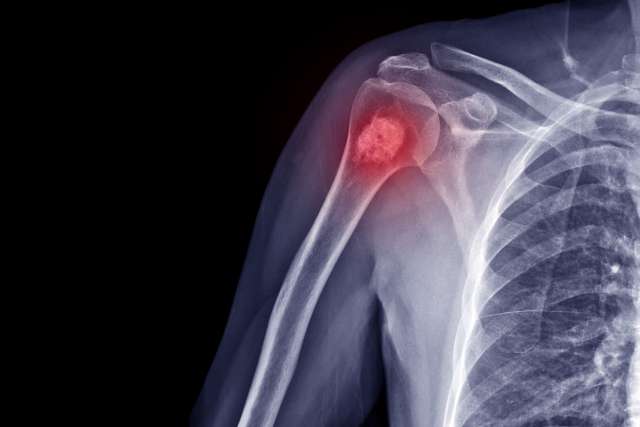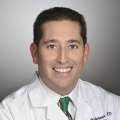Orthopedic Oncology
Our orthopedic oncology team offers multispecialty, state-of-the-art care. We are one of the highest-volume bone and soft tissue tumor treatment centers in the country.

UCLA Health Excellence in Orthopedic Oncology
Our orthopedic oncology doctors perform the highest volume of surgery for bone and soft tissue tumors on the West Coast. We also rank among the top three highest-volume treatment centers in the country. This means that children and adults receive expert treatment from physicians with vast experience. Our team offers comprehensive, state-of-the-art care with compassion.
Highlights of our program include:
Team-based approach: Experts from radiation oncology, medical oncology, orthopedic oncology and surgical oncology regularly meet to discuss each patient’s unique needs and find an effective treatment plan. This cohesive tumor board includes physicians who have been working together for many years. Patients benefit from their collective experience and knowledge of leading-edge treatment options.
Coordinated, patient-centered care: Orthopedic oncologists work closely with musculoskeletal radiologists to coordinate clinical and diagnostic care so patients can get answers quickly. Our aim is to ease patients’ anxieties during a stressful time. Patients also have access to a wide range of subspecialists throughout the UCLA Health system, and we can easily coordinate any necessary referrals.
Limb-sparing emphasis: All our orthopedic oncologic surgeons are trained in limb salvage. When it is safe to do so, we perform surgeries that preserve the limbs, maintaining function and quality of life for patients.
Physician expertise: Our surgeons have specialized training in microsurgery and endoprosthetic reconstruction (limb salvage surgery with implants). We also work closely with other surgical subspecialties to offer comprehensive surgical care for all patients.
Advanced treatment options: Our institutional history boasts the largest series of metal implants for limb salvage procedures in the region. UCLA Health specialists use a wide range of advanced techniques, including custom implants for particularly complex needs, targeted muscle reinnervation for phantom limb pain and expandable implants for limb-length equality.
Our areas of care
The orthopedic oncology team collaborates with multiple specialists throughout UCLA Health to offer targeted, comprehensive care. Areas of care include:
Sarcoma Program
Our orthopedic oncologists care for patients with soft tissue tumors through our specialized Sarcoma Program. We are one of the nation’s busiest sarcoma programs, treating more than 1,200 patients each year. Patients can find leading-edge care close to home at several clinic locations throughout the greater Los Angeles region.
Conditions orthopedic oncologists treat
Orthopedic oncologists are doctors who treat the full range of cancerous (malignant) and noncancerous (benign) bone and soft tissue tumors, including:
Benign soft tissue tumors
These noncancerous tumors grow in the soft tissues, which include muscles, fat, blood vessels, tendons and nerves. Tumor types may include:
Ganglion cyst: Round or oval jelly-filled lumps beneath the skin, usually occurring at the wrist
Giant cell tumor of soft tissue: Tumors that are made up of many unusually large or “giant” cells formed from the joining of several smaller cells
Glomus tumor: A growth starting in the glomus body, a component of the inner layer of skin (dermis)
Lipoma: A fatty lump that develops between the muscle and skin
Neurofibroma: A tumor that grows on nerves, forming a soft bump on or beneath the skin
Schwannoma: A tumor that starts in Schwann cells, which protect and support nerve cells
Tenosynovial giant cell tumor of the tendon sheath: Giant cell tumors that form in the tissue that surrounds tendons (tendon sheath), often occurring in the hands or feet
Malignant soft tissue tumors
Also known as soft tissue sarcomas, these cancerous tumors start in any of the soft tissues. Types include:
Epithelioid sarcoma: A rare, slow-growing tumor usually starting in the soft tissue of the arms or hands
Invasive skin cancer: Skin cancer that has grown past the outer layer of skin (epidermis) and into the dermis and surrounding tissues
Leiomyosarcoma: A rare cancer that grows in smooth muscles, which include those in the intestines, bladder, stomach, blood vessels and uterus
Liposarcoma: Cancer that starts in fatty tissue
Radiation sarcoma (radiation-induced sarcoma): A rare tumor that arises after radiation therapy and differs from the original tumor treated
Undifferentiated pleomorphic sarcoma : Soft tissue tumors in which the tumor cells look different from the cells of surrounding tissue, with tumor cells growing in multiple sizes and shapes
Benign bone tumors
Benign bone tumors include noncancerous growths that start in any of the bones throughout the body. These tumors may include:
Aneurysmal bone cyst: A blood-filled growth in the bone that tends to get bigger
Chondroblastoma: A rare bone tumor that starts in the cartilage at the end of bones
Enchondroma: A rare bone tumor that starts in the cartilage inside bones
Eosinophilic granuloma: A condition in which lesions grow in bones, often in the skull, spinal bones, ribs or limbs
Fibrous dysplasia: A rare condition in which scar-like tissue grows where bone tissue should grow
Giant cell tumor of bone: Tumors that are made up of many unusually large or “giant” cells formed from the joining of several smaller cells, usually occurring at the end of a joint
Nonossifying fibroma: Bone lesions made up of scar (fibrous) tissue, commonly occurring in children
Osteochondroma: A mass of cartilage and bone that develops at the end of bones near growth plates, often in the legs, shoulder blade or pelvis
Synovial chondromatosis: A rare condition in which the synovium, the layer of tissue lining joints, grows atypically and forms small growths made of cartilage
Unicameral bone cyst: A fluid-filled cavity in a bone, usually affecting the upper arm bone (humerus) or upper leg bone (femur)
Malignant Bone Tumors
Cancerous growths that start in or spread to bones, including:
Bone marrow cancer: Cancer that starts in the bone marrow, the sponge-like tissue inside bones
Chondrosarcoma: A type of bone cancer starting in cartilage cells
Ewing sarcoma: A rare tumor starting in bones or soft tissues around bones, usually occurring in the pelvis or leg bones
Lymphoma: Cancer that starts in lymphocytes, the infection-fighting cells found in bone marrow, lymph nodes, the spleen and other parts of the body
Metastatic bone disease: Any form of cancer that starts elsewhere in the body and spreads to the bones
Myeloma: Cancer of the plasma cells, which produce infection-fighting cells called antibodies and are found in bone marrow
Osteogenic sarcoma (osteosarcoma): Cancer that starts in the bone cells, often developing at the ends of bones where new tissue forms as children grow
Plasmacytoma: A bone tumor starting in plasma cells, possibly turning into myeloma
Treatments orthopedic oncologists offer
Our orthopedic oncologists are experts in a range of advanced techniques and procedures, including:
Limb salvage and reconstruction: These procedures aim to remove tumors fully without removing an entire limb. The surgeon may remove bone surrounding the tumor and replace it with an implant to maintain the limb’s function.
Expandable bone implants: These implants can be expanded as a child grows, without the need for reoperation. A special device uses a magnet to lengthen the implant, and patients can go home the same day as treatment.
Mass excision: These surgeries remove soft tissue tumors. The surgeon may also remove a small portion of surrounding tissue. The mass gets sent to a lab for testing to learn more about the tumor type and function.
Curettage: The surgeon uses an instrument called a curette to scrape away a benign bone tumor. In some cases, the bone may be able to grow back and fill in where the tumor was. For other patients, the surgeon may combine curettage with a bone graft or implant to fill in the cavity.
Amputation: Our surgeons opt for limb-sparing surgery as often as possible. But for some patients, removing part or all of a limb may be the best option for curing bone or soft tissue cancer.
Targeted muscle reinnervation: Surgeons reassign the nerves that control muscle movements so that patients can control prosthetic limbs by thought. This procedure can be effective for reducing phantom limb pain in patients who have had amputations.
Treatment of metastatic disease: Patients may have other cancer treatments if the disease has spread (metastasized) through the body. A care plan may include one or more treatments such as chemotherapy, radiation therapy, targeted therapy or immunotherapy.
Meet our team
Our orthopedic oncologists expertly treat the full range of bone and soft tissue tumors. We specialize in advanced, complex techniques, always prioritizing patients’ function and quality of life.
Physicians
Affiliated Physicians
Physician Assistant
Contact us
Call 424-259-9860 to request an appointment with an orthopedic oncologist at UCLA Health.
Find Your Care
Our orthopedic oncologic surgeons offer a range of advanced techniques, specializing in limb salvage procedures. Call 424-259-9860 to learn more about orthopedic oncology services.
Fax: 424-259-6560






